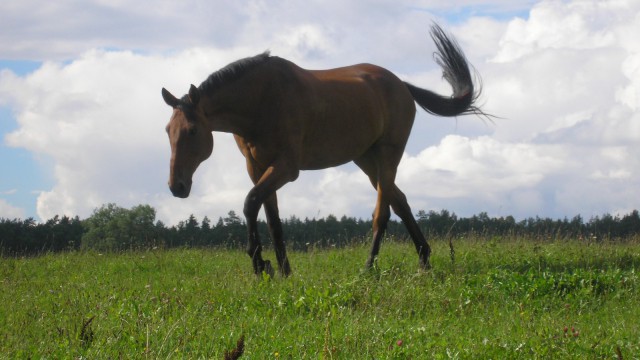Understanding and managing pinworm

Oxyuris equi, more commonly known as Pinworm, can often be seen in horse dung even after treatment. There are regular postings on equine forums on the subject which are often inaccurate or ill-informed, and there can be a tendency to blame wormer resistance for the problem.
This article, written by the experts at Virbac, aims to describe the lifecycle of the worm, in order to help explain the treatment and management options available.
Life cycle of the pinworm
Adult worms live in the large intestine (caecum and colon). From there, the female worms migrate to the rectum when they are ready to lay their eggs. They poke their tails through the anus and deposit clumps of eggs in a gel like substance. This can sometimes be seen as yellow/white jelly like streaks around the anus.
The eggs are not capable of infecting other horses immediately, but they mature quickly and can be infective within five days. Horses are intensely itchy when the eggs are laid, rubbing their hindquarters on objects. This can cause eggs to fall off into the environment.
The horse becomes infected by ingesting infective eggs from the environment, for example its pasture, stables, bedding or food. Once digested, the larvae migrate to the large intestine and burrow into the intestinal walls and develop into adults. This process from egg to adult can take five months.
The adult female worm lives around six months and can lay up to 50,000 eggs in this time, presenting a significant source of environmental contamination.
Detection
Pinworm cannot be detected routinely in faecal worm egg counts, as eggs are laid under the horse’s tail and not often passed out in faeces. One way to confirm the diagnosis is by doing a “sticky-tape” impression from under the tail and examining it under a microscope for eggs, however this will only detect 50% of infections.

Pinworms are very distinctive and are recognisable by their rounded bodies that taper down to a point, very similar to bean sprouts. The eggs are also recognisable as they are oval shaped with one slightly straighter side and a “cap” at one end. Figure 1 shows an embryonated egg and the larva can be seen within the shell.
Pinworm infection within the intestines rarely cause gastro-intestinal clinical signs, and a horse may have a few eggs or worms which may not be causing any problems. Colic, weight loss and diarrhoea that may be seen with other worm infections are not associated with Pinworm.
The first thing an owner may notice is the horse rubbing its back end more, rub marks over the rump and hair loss resulting in ‘rat tail’ (figure 2, below). This causes a cosmetic problem, but in more severe cases can lead to trauma in the tail and perianal region with traumatised, oozing sores.
Control
Routine worming will help to control the life stages in the small intestines so it is important horse owners take measures to ensure accurate dosing. Accurate dosing relies primarily on accurate weight estimation and effective delivery of wormer.
If your horse is difficult to worm with syringe wormers, then there are also wormers available in a tablet form to help address spit out. Please consult your vet or SQP (Suitably Qualified Person) – they can advise you further.

Other measures of control also need to be implemented to break the re-infection cycle. While incredibly useful for other worm types, poo picking is of limited value against pinworm, as the infective eggs are stuck around the anus and few are in the faeces.
Horse hygiene is an important factor in breaking the re-infection cycle. Washing the area under the tail will help to soothe any irritation and remove the eggs. This should be done every 2-3 days and will reduce environmental contamination and prevent re-infection. In many ways tail washing for pinworm should be viewed in the same way as poo-picking for most other worm species, particularly in sensitive horses.
Also, don’t forget to clean where the horses have been seen to rub themselves. Regular changing of bedding and feed troughs to decrease contamination can also help.
Pinworm can be tricky to control. Accurate dosing of wormers is vital, together with implementing a strict hygiene protocol. This will aid in breaking the re-infection cycle. Remember, Pinworms very rarely cause intestinal problems. Keeping an eye out for your horse rubbing its hind quarters.
If you have any concerns regarding your horse, it is always best to consult a veterinary professional.






